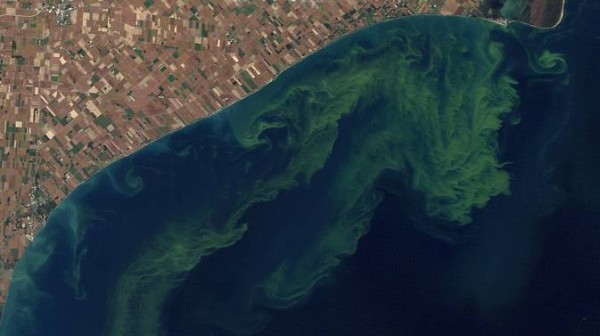Federal Agencies Join Forces to Design Early Warning System for Freshwater Toxic Algal Blooms
| Marco Foronda | | Apr 09, 2015 02:36 AM EDT |
(Photo : USGS/NASA Earth Observatory) Toxic algal blooms like this one in Lake Erie in 2011 can cause human and animal health risks, fish kills, and degrade drinking water supplies.
Four federal agencies joined together in transforming satellite data designed to probe ocean biology into information that will help protect the American public from harmful freshwater algal blooms.
The US$3.6 million research project is a collaborative effort among NOAA, NASA, U.S. Environmental Protection Agency and U.S. Geological Survey. It's designed with the intent to use methods and technology to analyze ocean color satellite data, develop an early-warning indicator for toxic and nuisance algal blooms in freshwater systems and build an information distribution system to expedite public health advisories.
Like Us on Facebook
The project plans to share information with local authorities and make it available to the public from websites and mobile devices.
"Observing harmful algae is critical to understanding, managing, and forecasting these blooms. This collaboration will assure that NOAA's efforts will assist the coastal and inland public health officials and managers across the country to distribute this information to the community in an easily understandable fashion, making them more resilient to environmental events," said Holly Bamford, Ph.D., acting assistant secretary of commerce for conservation and management, and deputy NOAA administrator.
The new network will assemble previous NASA ocean satellite sensor technologies created to study the global ocean's microscopic algal communities that play a major role in ocean ecology, the movement of carbon dioxide between the atmosphere and ocean, and climate change.
These sensors identify the color of the sunlit upper layer of the ocean and are used to create indicators that can help identify harmful algal blooms.
Ocean color satellite data is currently accessible to scientists, but is not routinely processed and produced in formats that can meet the needs of state and local environmental and water quality managers. This project will convert the satellite data on cyanobacteria blooms developed by the four partner agencies to a format the public can use through a mobile devices and web portals.
The project also includes a research component to improve understanding of the environmental causes and health impacts of cyanobacteria and phytoplankton blooms across the United States.
The project's mission is to understand and predict changes in the Earth's environment, from the depths of the ocean to the surface of the sun, and to conserve and manage our coastal and marine resources.
TagsFederal Agencies Join Forces to Design Early Warning System for Freshwater Toxic Algal Blooms, four federal agencies, Freshwater Toxic Algal Blooms, Algal Blooms, NOAA, NASA, U.S. Environmental Protection Agency, U.S. Geological Survey, ocean color satellite, ocean color satellite data
©2015 Chinatopix All rights reserved. Do not reproduce without permission
EDITOR'S PICKS
-

Did the Trump administration just announce plans for a trade war with ‘hostile’ China and Russia?
-

US Senate passes Taiwan travel bill slammed by China
-

As Yan Sihong’s family grieves, here are other Chinese students who went missing abroad. Some have never been found
-

Beijing blasts Western critics who ‘smear China’ with the term sharp power
-

China Envoy Seeks to Defuse Tensions With U.S. as a Trade War Brews
-

Singapore's Deputy PM Provides Bitcoin Vote of Confidence Amid China's Blanket Bans
-

China warns investors over risks in overseas virtual currency trading
-

Chinese government most trustworthy: survey
-

Kashima Antlers On Course For Back-To-Back Titles
MOST POPULAR
LATEST NEWS
Zhou Yongkang: China's Former Security Chief Sentenced to Life in Prison

China's former Chief of the Ministry of Public Security, Zhou Yongkang, has been given a life sentence after he was found guilty of abusing his office, bribery and deliberately ... Full Article
TRENDING STORY

China Pork Prices Expected to Stabilize As The Supplies Recover

Elephone P9000 Smartphone is now on Sale on Amazon India

There's a Big Chance Cliffhangers Won't Still Be Resolved When Grey's Anatomy Season 13 Returns

Supreme Court Ruled on Samsung vs Apple Dispute for Patent Infringement

Microsoft Surface Pro 5 Rumors and Release Date: What is the Latest?










